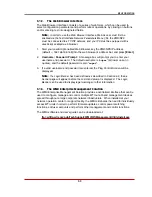
4-2
Hardware Installation
4.1.2. Connect the VMR or NPS to Your Power Supply
Refer to the cautions listed below and at the beginning of this User's Guide, and then
connect the VMR/NPS unit to an appropriate power supply.
Note:
Some VMR/NPS units are shipped with one or two detachable 125 VAC,
15 Amp "Starter" Cables. These cable(s) will allow you to connect a 120 VAC
VMR/NPS unit to power for bench testing and initial start up and are adequate
for applications that only require 15 Amps. For higher amp power switching
applications, please refer to the WTI Power Cable Guide (which can be found
on the CDROM included with the unit) or use appropriate cables.
CAUTIONS:
• Before attempting to install this unit, please review the warnings and
cautions listed at the front of the user’s guide.
• This device should only be operated with the type of power source
indicated on the instrument nameplate. If you are not sure of the type of
power service available, please contact your local power company.
• Reliable earthing (grounding) of this unit must be maintained. Particular
attention should be given to supply connections when connecting to
power strips, rather than directly to the branch circuit.
• VMR/NPS models may include up to four power inlets to allow
connection to multiple power supplies.
4.2. Connection to Switched Outlets
Connect the power cord from your switched device to one of the AC Outlets on the
VMR/NPS unit. Note that when power is applied to the VMR/NPS, the AC Outlets will be
switched “ON” by default. Note that some VMR/NPS models include up to four separate
power branches, while others feature only one power branch.
4.3. Serial SetUp Port Connection
The VMR/NPS SetUp Port is a female, RJ45 RS232 connector, wired in a DCE
configuration. In the default state, the Setup port is configured for 9600 bps, no parity,
8 data bits, 1 stop bit. The Setup Port can be connected to either an external modem or
a local PC, but not both items at the same time. Appendix B.1 describes the Setup Port
interface.
4.3.1. Connecting a Local PC
Use the DX9F-WTI Adapter supplied with the unit to connect your PC COM port to the
VMR/NPS Setup Port. Make certain that the Serial Port Mode is set to “Normal” as
described in Section 6.7.
4.3.2. Connecting an External Modem
When connecting directly to an external modem, use the optional DX9M-RJ-KIT (not
included) to connect your external modem to the VMR/NPS Setup Port. Make certain
that the modem is initialized at the same default parameters as the VMR Setup Port and
that the VMR/NPS Serial Port Mode is set to “Modem” as described in Section 6.7.






























